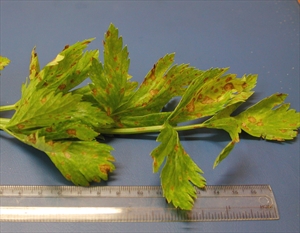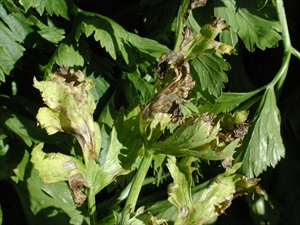Celery early blight
Pacific Pests, Pathogens and Weeds - Online edition
Pacific Pests, Pathogens & Weeds
Celery early blight (136)
Cercospora apii
Asia, North and South America, Oceania. It is recorded from Australia, and Samoa.
Celery
The fungus develops on the older, outer leaves first. It produces small yellow spots (up to 12 mm diameter) on the leaves and these develop rapidly in wet weather, becoming irregular in shape with greyish centres (Photos 1-3). Spores are produced mostly on the underside of the spots. The affected areas become dry and papery. When conditions favour the disease, elongated spots also occur on the leaf stalks.
The fungus survives on crop remains, and also in seed. Spores are spread short distances in water-splash, on machinery and people; spores are spread long distances by wind, and also on seed.
In Samoa, the disease has been recorded on celery throughout the year, and can be very damaging on the leaves.
Look for the small yellow spots, enlarging to irregularly rounded spots with greyish centres. Look for the infected areas that rapidly become dry, papery, and develop into a blight.
CULTURAL CONTROL
Before planting:
- Treat seed in hot water (48°C for 30 minutes). Do not treat old seed (>3 years); it is less able to withstand the treatment, and the fungus does not live on the seed for more than 3 years.
- Grow seedlings in soilless or pasteurized media in clean trays. Check regularly for signs of disease, and discard any plants with symptoms.
During growth:
- Use wide plant spacing and raised beds to improve air circulation, so that the leaves dry out as rapidly as possible.
- In commercial plantings, use drip irrigation. If using overhead irrigation, time it so that plants dry out rapidly after watering.
After harvest:
- Dig in remains of the plants immediately after harvest to encourage rapid breakdown in the soil; alternatively, remove the plant remains and burn, bury or compost them.
CHEMICAL CONTROL
Seed treatment: Treat seed with thiram fungicide. Treatment with thiram will also prevent seedling damping-off.
In the field: Fungicides are commonly used to control this disease, and both protectant (e.g., mancozeb, copper formulations and chlorothalonil), and systemic products (e.g., those in the strobilurin and demethylation-inhibiting groups) are used.
____________________
When using a pesticide, always wear protective clothing and follow the instructions on the product label, such as dosage, timing of application, and pre-harvest interval. Recommendations will vary with the crop and system of cultivation. Expert advice on the most appropriate pesticides to use should always be sought from local agricultural authorities.
AUTHOR Grahame Jackson
Information (and Photo 1) from Diseases of vegetable crops in Australia (2010). Editors, Denis Persley, et al. CSIRO Publishing; and from Gerlach WWP (1988) Plant diseases of Western Samoa. Samoan German Crop Protection Project, Deutsche Gesellschaft für Technische Zusammenarbeit (GTZ) Gmbh, Germany; and CABI (2019) Cercospora apii (early blight: celery). Crop Protection Compendium. (https://www.cabi.org/cpc/datasheet/12185); and Chaput J (2000) Identification and management of celery leaf blights. Ministry of Agriculture, Food and Rural Affairs. Ontario. (http://www.omafra.gov.on.ca/english/crops/facts/00-093.htm); and from Kolke ST, et al. (2008) Celery Early blight. University of California Statewide IPM Program. Agriculture and Natural Resources, University of California. (http://ipm.ucanr.edu/PMG/r104100211.html). Photo 2&3 Jacquie (Wright) Kami, formerly Plant Pathologist, Secretariat of the Pacific Community, Suva, Fiji.
Produced with support from the Australian Centre for International Agricultural Research under project PC/2010/090: Strengthening integrated crop management research in the Pacific Islands in support of sustainable intensification of high-value crop production, implemented by the University of Queensland and the Secretariat of the Pacific Community.







